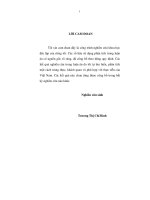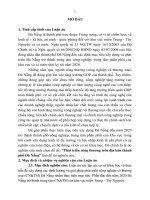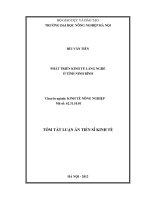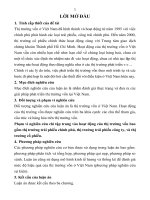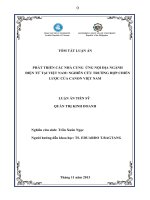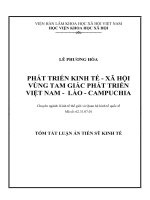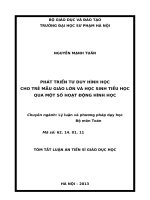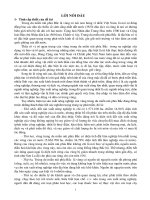(Luận án tiến sĩ) phát triển phương pháp tính toán phi tuyến đa tỉ lệ ngẫu nhiên cho vật liệu tổng hợp sợi ngắn ứng dụng cho nghiên cứu ảnh hưởng của cấu trúc vi mô biến đổi đến quá trình phát triển phá hỏng vật liệu
Bạn đang xem bản rút gọn của tài liệu. Xem và tải ngay bản đầy đủ của tài liệu tại đây (5.1 MB, 122 trang )
Luận Án Tiến Sỹ Kỹ Thuật
Phát triển phương pháp tính toán phi tuyến đa tỉ lệ ngẫu
nhiên cho vật liệu tổng hợp sợi ngắn ứng dụng cho
nghiên cứu ảnh hưởng của cấu trúc vi mơ biến đổi đến
q trình phát triển phá hỏng vật liệu
8/2020
Khoa Sau Đại Học Về Khoa Học Và Kỹ Thuật
Đại Học Keio
Hoàng Tiến Đạt
LUẬN ÁN
Đã nộp tới Đại học Keio và thỏa mãn hết các tiêu chí của bằng tiến sỹ
Nay, luận án này được nộp tới Đại học Thái Nguyên
I
Abstract
The mechanical properties of fiber reinforced composite materials are scattered
especially in the development of a new and cost-effective manufacturing process. The main
reason lies in the microstructural variability expressed by physical parameters of constituent
materials and geometrical parameters to express the morphology at microscale. The short fiber
reinforced composite materials can be fabricated easily by injection molding method, but they
have random microstructures. To solve the problem considering variability, there have been
many studies on the stochastic finite element method. The first-order perturbation based
stochastic homogenization (FPSH) method has been developed based on the multiscale theory
and verified for porous materials and multi-phase composite materials considering the
variability in physical parameters. However, its applications were limited to linear elastic
problems. Therefore, this study aims at the development of a stochastic nonlinear multiscale
computational method. In its application to short fiber reinforced composites, the final goal of
this study is to clarify the important random factors in the microstructure that give significant
influence on the damage propagation.
Firstly, the above FPSH method was extended for the stochastic calculation of
microscopic strain. This theory enabled us to analyze the damage initiation and propagation in
a stochastic way. Since huge scenarios exist in the nonlinear behaviors, however, a subsampling scheme was proposed in the analysis by FPSH method together with the sampling
scheme for geometrical random parameters. Furthermore, to reduce the computational time for
practical and large-scale analyses of stochastic damage propagation problems, a numerical
algorithm to accelerate the convergence of element-by-element scaled conjugate gradient
(EBE-SCG) iterative solver for FPSH method was developed. The efficiency was demonstrated
for spherical particulate-embedded composite material considering the damage in the coating
layer and the variability in physical parameter.
Finally, the developed computational method was applied to short fiber reinforced
composite materials. The fiber length distribution, fiber orientation denoted by two angles and
II
fiber arrangement were considered as the geometrical parameters in addition to a physical
random parameter. 11 models were analyzed having different fiber orientation and fiber
arrangement with variability. In the sub-sampling, 2 scenarios with 50% and 0.3% probabilities
were analyzed, which resulted in totally 22 cases. The differences among 22 possible damage
patterns were discussed deeply. It was figured out that very largely scattered degradation of
homogenized macroscopic properties was mostly affected by the fiber arrangement rather than
the fiber orientation. This finding was different from the result in linear elastic region. The
physical random parameters were more influential on the macroscopic properties. Also in these
analyses, the accelerated EBE-SCG method was again shown to be efficient.
III
Acknowledgements
First and foremost, I would like to give my deep gratitude to my advisor Prof. Naoki Takano,
who is one of my great and respected teachers in my life. He always gives me very clear guidance
and suggestions from the first contact before entering to Keio University until now. When I was
stuck in some difficult tasks, he encouraged, taught and provided very good ideas to motivate me.
He is very close and smiling with students in the discussion. Besides asking about my research, he
sometimes asks about my family and my student life and understands the difficulties of international
students in Japan. Without him, I could not complete my research and learn much new knowledge.
I am deeply grateful to him for being my advisor.
I am sincerely grateful to Prof. Fukagata, Prof. Omiya, and Assist. Prof. Muramatsu for
being the reviewers of my dissertation. From their valuable questions and comments, I could
improve the dissertation well and understand more about the limitations as well as the potential
applications of my proposed method in the future works.
I would like to extend my thankfulness to Assoc. Prof. Akio Otani (Kyoto Institute of
Technology) for supporting the measured fiber length data, and Prof. Heoung-Jae Chun (Yonsei
University) for giving me necessary knowledge about composite materials. I also would like to
thank all my labmates for three years at Keio University. Especially, Mr. Kohei Hagiwara came to
take me in Haneda airport and helped me prepared for my student life on the first days in Japan;
And, Mr. Daichi Kurita, Mr. Yutaro Abe, Mr. Lucas Degeneve, and Mr. Ryo Seino joined to discuss
my research topic and assisted me to use some Japanese software in our Lab. Besides, Mr. Yuki
Nakamura, Mr. Tatsuto Nose, and Ms. Mizuki Maruno also helped me to easily get involved in the
student life, and Japanese culture. I also would to thank Dr. Akio Miyoshi and Mr. Shinya Nakamura
from Insight, Inc., company for helping us to develop the Meshman Particle Packing software.
Next, I greatly thank the Ministry of Education, Culture, Sports, Science and Technology
of Japan for supporting the full scholarship (Monbukagakusho – MEXT) to me in 3 years at Keio
University. In addition, I would like to thank Keio University for providing the Keio Leading-Edge
Laboratory of Science and Technology (KLL) funding. I also want to express my gratitude to my
home university, Thai Nguyen University of Technology for giving me an opportunity to study in
Japan, keeping my lecturer position when I come back, and also paying a part of my salary.
Finally, I would like to give millions of love to my parents, my wife, my daughter, and my
son. They always encourage and look forward every single day of my life. Especially, I could not
express my words to describe the sacrifice of my wife to take care of the children when I was not
at home (2 internships in USA, 2 years in Taiwan and 3 years in Japan). To show my gratitude
towards everybody, I tried to hard study every day to complete the tasks as well as possible. This
dissertation is the achievement that I would like to give to everyone.
IV
Chapter of Contents
Abstract ..................................................................................................................................... II
Acknowledgements .................................................................................................................. IV
Chapter of Contents ................................................................................................................... V
List of Figures ....................................................................................................................... VIII
List of Tables ............................................................................................................................ XI
Abbreviation ............................................................................................................................XII
Nomenclatures ....................................................................................................................... XIII
Chapter 1 Introduction ............................................................................................................... 1
1.1
Motivation ................................................................................................................... 1
1.2
Short fiber reinforced composite materials ................................................................. 6
1.2.1.
Injection molding and conventional micromechanical model ............................. 6
1.2.2.
Fiber length, fiber orientation and fiber arrangement .......................................... 8
1.3
Aims and scopes of research ..................................................................................... 11
1.4
Structure of dissertation ............................................................................................. 12
Chapter 2 Literature review and methodologies ...................................................................... 14
2.1
Micromechanics, multiscale approach and homogenization with composite
materials ............................................................................................................................... 14
2.2
Damage model and damage criteria .......................................................................... 20
2.3
Variability, uncertainty or randomness ..................................................................... 26
2.3.1
Variability of physical properties ....................................................................... 26
2.3.2
Variability of geometrical parameters ................................................................ 27
2.3.3
Variability of loading and boundary conditions ................................................. 28
2.3.4
Variability of manufacturing process parameters .............................................. 28
V
2.4
Stochastic finite element methods ............................................................................. 29
2.5
First-order perturbation based stochastic homogenization method for composite
materials ............................................................................................................................... 31
2.6
Stochastic modeling of fiber reinforced composites ................................................. 34
Chapter 3 Stochastic calculation of microscopic strain ........................................................... 36
3.1
Microscopic displacement ......................................................................................... 36
3.2
Derivation of microscopic strain in stochastic way ................................................... 38
3.3
Numerical example of microscopic strain considering only variability of physical
parameters ............................................................................................................................ 41
Chapter 4 Stochastic nonlinear multiscale computational scheme with accelerated EBE-SCG
iterative solver .......................................................................................................................... 50
4.1
Sampling and sub-sampling for stochastic nonlinear multiscale computational
scheme .................................................................................................................................. 50
4.2
Acceleration of EBE-SCG iterative solver ................................................................ 56
4.3
Numerical example .................................................................................................... 60
4.3.1
Verification of the accelerated EBE-SCG solver by characteristic displacement
visualization ..................................................................................................................... 60
4.3.2
Stochastic damage propagation .......................................................................... 65
4.3.3
Degradation of homogenized properties ............................................................ 68
4.3.4
Acceleration of solution for nonlinear simulation .............................................. 68
Chapter 5 Application to short fiber reinforced composites to study the influence of
microstructural variability on damage propagation ................................................................. 71
5.1
Microstructural modeling and sampling .................................................................... 71
5.2
Numerical results ....................................................................................................... 77
5.2.1
Probable damage patterns................................................................................... 77
VI
5.2.2
Microscopic strain during damage propagation ................................................. 79
5.2.3
Homogenized properties in linear and nonlinear analysis ................................. 80
5.3
Acceleration of EBE-SCG during damage propagation ............................................ 81
5.4
Discussion of influence level of variability in physical and geometrical parameters 83
Chapter 6 Concluding remarks ................................................................................................. 87
List of publications ................................................................................................................... 91
References ................................................................................................................................ 92
VII
List of Figures
Fig. 1. 1 Distribution of mechanical properties of constituent materials ................................... 4
Fig. 1. 2 Influence of order on the variance of outcome result .................................................. 4
Fig. 1. 4 Injection molding process ............................................................................................ 7
Fig. 1. 5 Model of an injection molded structure ..................................................................... 10
Fig. 1. 6 Main points and their relations in structure of dissertation ........................................ 13
Fig. 2. 1 Multiscale framework ................................................................................................ 15
Fig. 2. 2 Unit cell array ............................................................................................................ 17
Fig. 2. 3 Classification of composite materials ........................................................................ 19
Fig. 2. 4 Rate of use for different failure criteria for composite materials in published papers
by others ................................................................................................................................... 23
Fig. 2. 5 General framework of stochastic finite element approach ........................................ 30
Fig. 2. 6 Two-scale problem of heterogeneous media ............................................................. 33
Fig. 3. 1 Flowchart of damage analysis formulation ................................................................ 36
Fig. 3. 2 Definition of SVE for short fiber-reinforced composite material .............................. 42
Fig. 3. 3 Microscopic strain 33 in interphase and short fibers when random physical
parameters for all constituent materials are considered ........................................................... 45
Fig. 3. 4 RVE models of glass fiber reinforced plastics composite based on the lognormal
distribution ............................................................................................................................... 47
Fig. 3. 5 Definition of two cross-sections ................................................................................ 48
Fig. 3. 6 Microscopic effective strain distributions on the cross-section 1-2 under macroscopic
strain E31 0.02 102 ............................................................................................................ 49
Fig. 3. 7 Microscopic effective strain distributions on the cross-section 2-3 under macroscopic
strain E31= 0.02 102 ............................................................................................................ 49
VIII
Fig. 4. 1 General flowchart of research algorithm ................................................................... 53
Fig. 4. 2 Detail algorithm of stochastic damage propagation analysis ..................................... 54
Fig. 4. 3 Accelerated procedure for the EBE-SCG solver in Fig. 4.1 ...................................... 57
Fig. 4. 4 Visualization of characteristic displacements of two successive sub-cycles ............. 58
Fig. 4. 6 SVE model of coated particle-embedded composite material ................................... 60
Fig. 4. 7 Finite element model of coated particle-embedded composite material ................... 61
Fig. 4. 8 Zeroth-order terms of characteristic displacements in x direction 0 of two
x
11
successive sub-cycles at (a) cycle 1 and (b) cycle 17 .............................................................. 62
Fig. 4. 9 Zeroth-order terms of characteristic displacements in y direction 0 y of two
11
successive sub-cycles at (a) cycle 1 and (b) cycle 17 .............................................................. 63
Fig. 4. 10 Zeroth-order terms of characteristic displacements in z direction 0 of two
z
11
successive sub-cycles at (a) cycle 1 and (b) cycle 17 .............................................................. 63
Fig. 4. 11 First-order terms of characteristic displacements in x direction 31 of two
x
11
successive sub-cycles at (a) cycle 1 and (b) cycle 17 .............................................................. 64
Fig. 4. 12 First-order terms of characteristic displacements in y direction 31 of two
y
11
successive sub-cycles at (a) cycle 1 and (b) cycle 17 .............................................................. 64
Fig. 4. 13 First-order terms of characteristic displacements in z direction 31 of two
z
11
successive sub-cycles at (a) cycle 1 and (b) cycle 17 .............................................................. 65
Fig. 4. 14 Stochastic damage propagation of coated particle-embedded composite material . 66
Fig. 4. 15 Damage element visualization of a half of coating .................................................. 67
Fig. 4. 16 Damage element visualization of a half of coating .................................................. 67
Fig. 4. 17 Degradation of homogenized macroscopic properties DH when ............................ 68
Fig. 4. 18 Acceleration ratios and convergence histories in EBE-SCG iterations to calculate 69
Fig. 4. 19 Acceleration ratios and convergence histories in EBE-SCG iterations to calculate 70
IX
Fig. 5. 1 Microstructure modeling for skin-core-skin layered specimen of injection molded
short fiber reinforced composite material ................................................................................ 72
Fig. 5. 2 Example model of Meshman Particle Packing .......................................................... 73
Fig. 5. 3 Microstructure models with different fiber arrangements for given fiber angel
variabilities by modified Meshman ParticlePacking ................................................................ 74
Fig. 5. 4 Definition of fiber orientation and SVE model of short fiber reinforced composites 75
Fig. 5. 5 Initial configuration of samples for cycle 1, 1 X S ...................................................... 76
Fig. 5. 6 Some damage patterns predicted at cycle 3, E = 0.005, 3 X nS (n = 0 or 3)................. 78
Fig. 5. 7 Influence of physical parameters on damage pattern when the properties of matrix 78
Fig. 5. 11 Strain distributions in matrix highlighting on high strain value and on the............. 80
Fig. 5. 12 Degradation of apparent stiffness ............................................................................ 81
Fig. 5. 13 Number of EBE-SCG iterations and damaged volume evolution of a sample
X 3S X 1A|2 .................................................................................................................................. 82
Fig. 5. 14 Number of EBE-SCG iterations and damaged volume evolution of a sample
X 3S X 1A|4 .................................................................................................................................. 83
Fig. 5. 15 SVE specification in degraded apparent stiffness with enlarged views on the ........ 84
Fig. 5. 16 Influence of fiber arrangement on damaged volume evolution ............................... 85
Fig. 5. 17 Homogenized properties without damage ............................................................... 86
Fig. 5. 18 Variability influence level of physical and geometrical parameters ........................ 86
X
List of Tables
Table 1 Expected values of components in stress–strain matrices........................................... 42
Table 2 Engineering constants ................................................................................................. 47
Table 3 Random parameters ..................................................................................................... 47
Table 4 Engineering constants ................................................................................................. 61
Table 5 Setting of samplings .................................................................................................... 76
Table 6 Properties of constituent materials .............................................................................. 76
Table 7 Legend of characteristic displacements ...................................................................... 81
XI
Abbreviation
BBA: Building block approach
BC: Boundary condition
CDF: Cumulative density function
CDM: Continuum damage mechanics
Cov: Coefficient of variance
DEM: Discrete element method
EBE-SCG: Element-by-element scaled conjugate gradient
FEM: Finite element method
FPSH: First-order perturbation based stochastic homogenization
FRC: Fiber reinforced composite
IM: Injection molding
KL: Karhunen-Loeve
MCS: Monte Carlo simulation
PC: Polynomial Chaos
PDF: Probability density function
RVE: Representative volume element
SFEM: Stochastic finite element method
SFRC: Short fiber reinforced composite
SFRP: Short fiber reinforced plastic
SVE: Statistical volume element
UD: Unidirectional
X-FEM: Extended finite element method
CTE: Coefficient of thermal expansion
XII
Nomenclatures
Chapters 1, 2, 3: Multiscale method and first-order perturbation based
stochastic homogenization method
LN
f()
Σ
Average fiber length, N is number of fibers
Probability density function
Volume average stress
DXH
Volume average stress
Volume of the RVE
Domain
Elastic modulus
Index, i = 1, 2, 3
Index, j = 1, 2, 3
Index, k = 1, 2, 3
Index, l = 1, 2, 3
Young’s modulus
Shear’s modulus
Poisson ratio
Strength
Stress
Microscopic Strain
Stress-strain matrix
Mean value
Standard deviation
Variance
Average
Random variable
Four-order elastic tensor
Scale ratio
Homogenized properties of model X
u0
u1
δu
Macroscopic displacement
Perturbed displacement
Virtual displacement
uimicro
Microscopic displacement
Γ
Boundary
E
V
Ω
K
i
j
k
l
Ei
Gij
νij
Sij
σ
ε
D
Exp( )
S.D.( )
Var( )
Ave( )
α
Dijkl
λ
XIII
t
x
y
MTOT
Φ( )
Traction
Macroscopic scale
Microscopic scale
Total number of constituent material
Arbitrary function
Volume of an RVE
Characteristic displacement matrix
Deformation mode of characteristic displacement
|Y |
[χ]
kl
χ
0
χ
1
kl = 11, 22, 33, 23, 31, 12
Zero-order term of characteristic displacement vector
for kl mode
First-order term of characteristic displacement vector for
kl mode
Total number of constituent materials
kl
kl
NMAT
r
Constituent material number, 1 r NMAT
m
Index, 1 m 6
n
Index, 1 n 6
N
Br
Shape function
Strain-displacement matrix of constituent material r
A matrix to assign a scalar or random variable to
component of stress-strain matrix D
A vector to extract each column of stress-strain matrix D
Component mn of stress-train matrix D of constituent
material r
Random variable for component mn of stress-train
matrix D of constituent material r
P
Q
Dr,mn
αr,mn
Identity matrix
Expected value of homogenized properties
I
D H
0
DrH,mn
f (Xb)
1
The first order term of homogenized properties
corresponding to random variable αr,mn
Probability of model Xb
XIV
Chapters 4, 5: Stochastic nonlinear multiscale computational scheme
n
X Oj
Level of standard deviation of microscopic strain
n=0-3
Cycle
Sub-cycle
Constituent material number
Fiber arrangement sample index
Total number of fiber arrangement sample
Fiber orientation sample index
Total number of fiber orientation sample
Packing fiber orientation sample j
X iA| j
Fiber arrangement sample i in group orientation j
c
Sample at cycle c
c
s
r
i
imax
j
jmax
XS
c
X nS
X nS X iA| j
Sub-sample corresponding to n level of standard
deviation at cycle c
Sub-sample corresponding to n level of standard
deviation and fiber arrangement sample X iA| j
DXHi | j
Homogenized properties of model X i | j
εXi | j
Microscopic strain of model X i | j
DH
Mixture homogenized properties
Ave ε
Average microscopic strain
A
b
Stiffness matrix
Right-hand side vector
Effective microscopic strain
cr
Effective microscopic strain damage threshold
χ
0
kl
ini
χ
kl
1
r ini
χ
0
χ
kl
x , y ,z
kl
1
r x , y ,z
x
Initial vector of zero-order term of characteristic
displacement vector in EBE-SCG solver
Initial vector of first-order term of characteristic
displacement vector in EBE-SCG solver
Zero-order term of characteristic displacement vector
for kl mode in x, y, z direction
First-order term of characteristic displacement vector
for kl mode in x, y, z direction of constituent material r
Displacement
XV
p
δcr
γ
e
β
P
E
ΔE
np
Lf
d
g
Initial search direction
Residual vector
Convergence threshold
Search factor
Iteration
Updated search factor
Diagonal matrix of A
Macroscopic strain
Macroscopic strain increment
Number of particle
Fiber length
Diameter of fiber
Distance between two successive particle
XVI
Chapter 1 Introduction
1.1 Motivation
Heterogeneous and composite materials, like hardened steel, bronze or wood were
valued since ancient times because they provide better performance compared to the individual
phases or components which they consist of. Nowadays the idea of combining eligible materials
to form a composite material with new and superior properties compared to its individual
components is still subject to ongoing research. For example, polymers, which by nature have
a low density, can be reinforced by highly stiff and strong glass or carbon fibers, both
continuous and discontinuous. Such fiber reinforced composites excel in high specific
mechanical properties. For lightweight structures, high specific stiffness and strength are crucial
requirements. The higher the specific mechanical properties are the lighter a part or construction
can be designed. Hence, composite materials are increasingly attractive for fulfilling industrial
needs because their mechanical and physical-chemical properties can be adapted to meet
specific design requirements. To improve the performance of composites, multiscale study is
now a popular topic in computational mechanics. The real composite materials are
heterogeneous and characterized by various degrees of inherent variability or randomness.
Variability exists on all scales from the arrangement of a material microstructure to the structure
at the macroscale. Particularly, there may exist variability in the constituent material properties,
and geometries of the composite materials at various scales. The variability in these parameters
induces variability of the mechanical behaviour and damage evolution in the materials which
may cause severe random reflections of composite structures. Besides, the variability of the
materials may result in huge unpredicted scenarios of damage evolution. Damages in a
composite structure may remain hidden below the surface, undetectable by visual inspection
until the entire structure has failed.
For the improvements in the design processing technologies on cost-efficient design,
the building block approach (BBA) is applied to test scale-up from coupons, elements, and
subcomponents to establish final composite structures [1, 2]. This approach implies decreasing
1
the number of tests when moving from coupon tests level to testing of the entire products such
as aircraft or automobiles. This approach still results in a large number of mechanical tests
required for certification of new material because of variability or uncertainty (~104) [3]. The
total number of tests becomes enormous when several candidate materials are considered. At
the lower level of the BBA, the composite microstructures of coupons are often investigated by
virtual testing. The engineering constants, strengths, and strain-to-failure of a coupon are
estimated by tension, compression, and shear tests [2]. During manufacturing processes,
composite materials involve many randomness or variability in microstructures affecting the
quality of the component. This BBA needs to involve many experiments to achieve a safe
design. It results in excessive cost and time-consuming processes. Modelling of mechanical
behaviour can facilitate the development of new materials at all stages of the design chain and
reduce the number of real experiments during the certification process. And, the replacement
of a huge number of experimental tests of composite materials by the stochastic numerical
simulation considering the variability or uncertainty is a big matter of concern recently.
However, only a few of these variabilities have been studied in detail.
Multiscale modeling is a useful tool for predicting the effective macroscopic behaviour
of materials having a periodic structure at the microscale. Most of the modern approaches to
composites modelling are based on the well-established multiscale approach which suggests to
build a hierarchy of scale levels starting from the micro-scale of individual fibers up to the
macro-scale of components. Several analytical and computational models have been proposed
to calculate the mechanical properties of composite materials, such as multiphase materials [4–
6], short fiber reinforced composite (SFRC) structure [7, 8], metal/ceramic composites [9],
textile composite materials [10, 11], or particulate composite structures [12, 13]. The
asymptotic homogenization-based finite element method, a popular multiscale method, has
been widely used in the analysis of the mechanical properties of composite material [14–17].
However, conventional multiscale modeling does not explicitly account for variability
and uncertainty in the physical and geometrical parameters of microstructures. A few recent
studies have used a variety of numerical methods to address this. Xu [18] developed a multiscale
stochastic finite element method (SFEM) to resolve scale-coupling stochastic elliptic problems.
2
Savvas et al. [19] showed the effect that uncertainty in the constituent materials and the
geometry of the microstructure has on the macroscopic properties of composite materials, using
Monte Carlo simulation (MCS). Zhou et al. [20] proposed a perturbation-based stochastic
multiscale finite element method for calculating the mean values and coefficients of variation
of the effective elasticity properties of composite materials given the uncertainties of the
mechanical properties of the constituent materials. Wen et al. [21] presented a practical firstorder perturbation-based stochastic homogenization (FPSH) method that considers many
random physical parameters by using a finite element method (FEM). But these works have
only focused on the prediction of macroscopic properties of composite materials.
Stochastic multiscale computational approach should be developed to investigate not
only properties but also other behaviors, especially damage propagation in composite materials
considering the variability or uncertainty in their microstructures based on stochastically
analyzing microscopic strain or stress. Only a few papers seem to have examined microscopic
strain/stress or analyzed damage stochastically. Sakata et al. [22] reported a method of linear
analysis that uses first-order perturbation technique, analyzing a simple unidirectional fiberreinforced plastic to predict the initial probability of damage. Ma et al. [23] applied MCS to a
2D particle-matrix composite material. Ju et al. [24] took a micromechanical approach and
solved the problem in two dimensions for a fiber-reinforced titanium-alloy matrix composite
material to study the evolution of progressive damage from fiber breaking. Only a few works
were presenting the stochastic multiscale framework for initial damage prediction with simple
2D models to avoid high computational cost.
Applying a suitable method in nonlinear simulation to avoid high computational cost is
a big matter of concern, especially in stochastic nonlinear simulation. Mechanical properties of
constituent materials of composites considering uncertainty are often assumed distributed as
normal distributions with small covariance, i.e. less than 5% as shown in Fig. 1.1(a) [25, 26].
The influence of higher orders in perturbation method or polynomial expansion method on the
variation of the outcome result Φ is illustrated in Fig. 1.2(a). The first-order approach works
well in a small range of covariance less than 3% [27]. Figure 1.2(b) shows the first-order
perturbation function with respect to random variable ζ. Since to shorten the entire
3
computational process in nonlinear simulation, and since the results of the higher-order
approach are not always give higher accuracy than that of the first-order approach, the firstorder perturbation was used in this dissertation. The general formulation of the method will be
provided in Section 2.5.
Normal distribution
1
2
Cov
μ
e
1 x
2
2
Normal distribution
Probability density
Probability density
f x
f x
1
2
Cov
e
1 x
2
μ
x
2
x
(b) Large Cov
(a) Small Cov
Fig. 1. 1 Distribution of mechanical properties of constituent materials
Cov(Φ)
4th order
3rd order
Φ
2nd order
1st order
Φ =Φ0 + Φ1ζ
Φ0
Φ1=
3%
Φ
0
0
ζ
Cov(ζ)
(a) Influence of higher order formulation
(b) First-order perturbation
Fig. 1. 2 Influence of order on the variance of outcome result
Stochastic multiscale approach can be used to represent the macroscopic nonlinear at a
point in a composite structure. When investigating damage behavior at the macroscale, the
average properties of the materials are employed. Thus, the variability in microstructure is not
taken into account or the influence of microstructural variability cannot be observed by
macroscopic damage analysis. However, the failure appears at the micro scale and initiates from
the interface between fiber and matrix or interface between laminae. The debonding between
fiber and matrix as well as the small transverse cracks in matrix leads to delamination between
layers. Finally, the composite material and structure are totally broken by fiber breakage. Thus,
4
the microscopic damage is followed by macroscopic structural fracture. It is well known that
the multiscale methods can consider the microscopic damage behaviors, but there is a problem
when the variability or uncertainty at the micro scale is taken into consideration. The influence
of microstructural variability on the behaviors is limited only to local behavior, but will not be
clearly observed in macroscopic behavior. Some slight differences in microscopic behaviors
will result in almost the same macroscopic behavior because the macroscopic quantities are the
averaged ones of microscopically distributed quantities. In other words, slight differences will
be vanished by the averaging process. On the other hand, when variability or scattering was
seen in macroscopic behavior, to predict such behavior, since the parameter or index in
commonly used damage models (see Section 2.2) can be applied to macroscopic behavior of
fiber bundles and composite structures, the variability of those parameters must be determined.
It is easy to understand that the reliable distribution of damage parameters is hardly measured.
Moreover, it will be impossible to correlate with physical meaning in real phenomena, for
instance, by analyzing the posterior probability. On the other hand, the stochastic multiscale
analysis enables us to understand the variability in real phenomena and to analyze the source
of variability in measured data. When the interaction between macro- and microscopic
behaviors with variability is considered as mentioned above, it implies the possibility of
numerous scenarios for microscopic behaviors due to variability, although the macroscopic
behavior seems to be unique. Figure 1.3 illustrates this complexity more clearly. For example,
there are n models (samplings) when considering random geometrical parameters. Each sample
has m sub-models (sub-samplings) considering random physical parameters. The macroscopic
displacement-loading plot is achieved during the microscopic damage propagation by
stochastic nonlinear simulation. The number of obtained curves are the same number of the
multiple n × m. Due to the effect of random variables, the knee points are varied and the
variation of those curves will become larger after the knee points or in nonlinear zone because
of uncertainty propagation. It is very challenging to capture this phenomenon. Each response
curve is the combination of multi-phenomena from the microscale to macroscale during damage
propagation from time t1 to tk. Moreover, although the damage behaviors of different subsamplings are not the same, their macroscopic behaviors can be the same. This phenomenon
5
can be similar in case of different samplings. For this complicated multiscale problem, the
stochastic nonlinear simulation is needed. Specifically, the first-order perturbation based
stochastic homogenization method must be improved and extend to nonlinear simulation.
Recently, fiber reinforced composite (FRC) materials have many applications in a
broad range of engineering fields and industries such as aerospace, automobile, aviation, and
light industrial products, because of their low density, high strength and design flexibility [28].
Especially, SFRCs are being used extensively since they can be used to make large and complex
body parts [29]. In this dissertation, the development of the stochastic homogenization method
for damage prediction can be applied for all types of composite materials. However, particle
composites and short fiber reinforced plastics (SFRPs) are used as illustrations for the efficiency
of the new proposed scheme.
1.2 Short fiber reinforced composite materials
1.2.1. Injection molding and conventional micromechanical model
When fibers in a composite are discontinuous and are shorter than a millimeter, the
composite is called SFRC. Short fiber reinforced plastic (SFRP) composites have found
extensive applications in automobiles, business machines, durable consumer items, sporting
goods, and electrical industries, etc., because of their low cost, easy processing and their
superior mechanical properties over the parent polymers. Extrusion compounding and IM
processes are frequently employed to make SFRP composites. During the injection molding
(IM) process, fibers breakage also usually occurs, and a random orientation distribution, a fiber
length distribution, random fiber arrangement would result in the final product (see Fig. 1. 4).
The mechanical properties, such as strength, elastic modulus of SFRPs are critically dependent
on these morphological structures [30, 31]. The fiber orientation in SFRPs during the IM has
been the subject of several investigations [28]. To maximize the effectiveness of short glass
fiber structures in mechanical properties, damage behaviors, the variabilities or uncertainties of
their microstructures will be deeply considered in this work. The mechanical and physical
properties of SFRP composites have been the subject of much attention and are influenced to a
great degree by the type, amount and morphology of the reinforcing fibers, and the interfacial
6
bonding efficiency between the fibers and polymer matrix. Variables such as properties of
constituents, fiber volume fraction, orientation, arrangement, length or aspect ratio, and
interfacial strength are of prime importance
Variability to the final mechanical properties and3performances
Fiber
θ
exhibited by injection molded polymer composites [32].
y3
Skin layer
Inlet
x3
1
(c). Fiber orientation
Flow front
Mold wall Frozen layer
2h
Velocity
x2
x1
2
φ
Skin layer
layer
(b). Coupons (SVE) XCore
i j
Stream lines
Flow
direction
L
Core layer
y2
y1
P
Gate
Region
Shear rate
Lubrication
Region
Fountain
Region
(a). Injection molded element
Fig. 1. 3 Injection molding process
During the IM process, fibers breakage also usually occurs, and a random orientation
distribution, a fiber length distribution, random fiber arrangement would result in the final
product. Mortazavin and Faremi [28] investigated the anisotropic effects on tensile strength of
short fiber reinforced plastics (SFRP) and found the variation of these materials caused by fiber
orientation. Ioannis et al. [30] showed the larger effect of microstructure parameters such as
aspect ratio, fiber orientation on the macroscopic behavior of short fiber reinforced
thermoplastic composites. The mechanical properties of SFRPs are critically dependent on
these morphological structures, especially fiber orientation distribution which can result in the
unreliable determination of the deterministic computation [33]. The fiber orientation in SFRCs
made by IM has been optimized by Chen et al. [34]. Additionally, fiber arrangement in
microstructures of SFRPs should also be considered. To maximize the effectiveness of short
glass fiber structures in mechanical properties, damage behaviors, fiber orientation, and fiber
arrangement were deeply considered in this research.
For structural design of short fiber reinforced parts, micromechanical or numerical
models are often used to predict their properties and behavior. Many micromechanical models
7

